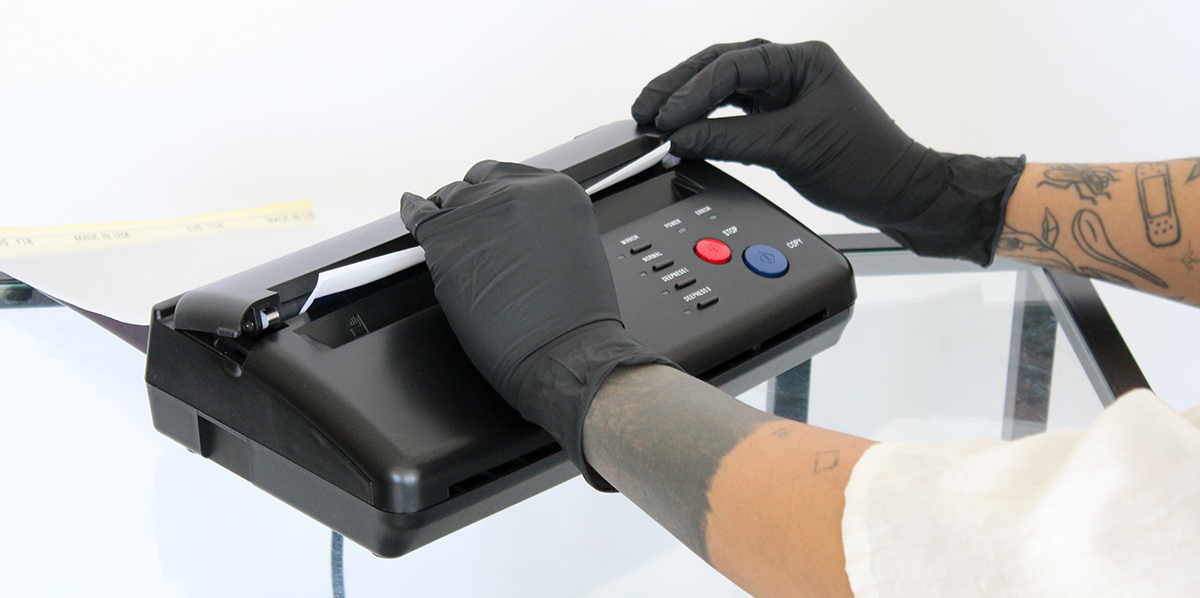Whether it’s a picture from the wall of the studio or a custom design brought in by a client, successful tattoo artists transfer designs from drawing to skin. But so many often wonder how exactly they do it.
Truth is, tracing is a time-honored artistic technique. Heck, the Renaissance masters would trace and transfer designs to a canvas before painting those priceless portraits and frescos in museums throughout the world. The best tattoo artists utilize this same process as a guide to accurately create intricate artwork on the skin. Dip pens and tracing paper are valuable tools used to create what is called a “tattoo stencil,” and helps ensure a client will get exactly what they want from their ink. After a traced design is applied, the artist can use their skills to follow the lines and fill in the blanks for the perfect tattoo. Here is how this whole thing works.
Creating the tattoo stencil
When a client selects the design they want tattooed, the artist will trace the image onto transfer paper (thin paper with an additional carbon sheet attached) or use a pen with stencil fluid on tracing paper. The special ink acts as a vehicle for a carbon copy of the design to be placed on the skin with the help of lotion or another stencil application product. This piece of paper is now a “stencil” and can be used multiple times to replicate the same image on different parts of the body.
Some shops have thermal copiers or printers with the capacity to copy and even resize images directly onto paper with the stencil fluid. Technology is a wonderful thing.
Keeping it simple
Tattoo lines sometimes can’t be made as fine as lines drawn by pencils or other art tools. If a client brings in a photograph or intricate design to be inked, the artist may have to simplify the image on the tattoo stencil by reducing the details in a way that is more compatible with tattooing techniques. Don’t worry, the artist will still create an excellent piece, it just helps to ensure that the final result won’t appear muddy or blurred.
Flipping it in reverse
Just like a selfie, the image on the stencil is a mirrored version of what a client wants the design to look like. This means the artist should remember to reverse the image when tracing because the ink will transfer backwards once it’s placed on the skin. Clients double-check that the artwork is in the direction they want it to be facing before the artist starts to use the needle.
Prepping for transfer
Before the design goes from stencil to skin, the artist will make sure the surface is optimal by cleaning the skin with antibacterial soap and shaving the area with a disposable razor. Once there is nothing but fresh canvas to apply the stencil, the artist will add a layer to the skin to make sure all of the ink adheres.
Transferring the design
After the area is prepped, the artist will carefully apply the stencil with the fluid side facing the skin. The stencil is patted onto the skin (not rubbed because that can create smudging) and left to sit for a few minutes.
The tattoo artist then slowly peels the paper off in a smooth motion from one side to the other. Both the artist and the client should check the placement and clarity of the design. If a correction is needed, this will require a full removal of the design with alcohol and another application of the stencil (better to make the mistakes with the stencil ink than the tattoo ink!). Once an exact replica of the design is placed in the right place on the skin and the artist and client are ready for the needle.
Going freestyle
There are tattoo artists who don’t use stencils and are quite good at drawing designs directly onto the skin. Some freehand tattoo artists draw a rough draft with a marker and use a spray to seal the design on the body before getting to work. Other freehand artists will use a variety of colored markers to gradually build a detailed design. These “permanent” markers are easily erased with special soap or rubbing alcohol.
Sometimes truly unique works are created by freehand artists who tattoo directly onto the skin without any guide or marker. This doesn’t mean that a client won’t be getting the exact design they want. But, the client won’t have the same visibility of seeing the image and exact positioning of the work before it is inked to the skin. In the end, clients should always do their research and only go with whatever method they are most comfortable with.
Staying involved in the process
Whether done by freehand or using a stencil, applying a mockup of the design before the process of inking onto the skin can help the client feel more involved in the process of putting a work of art on their body forever. The client can contribute their own creative input with the artist and truly collaborate on a rough draft of what the tattoo is going to look like.
Related: Here’s Everything You Need to Know About Single-Needle Tattoos

